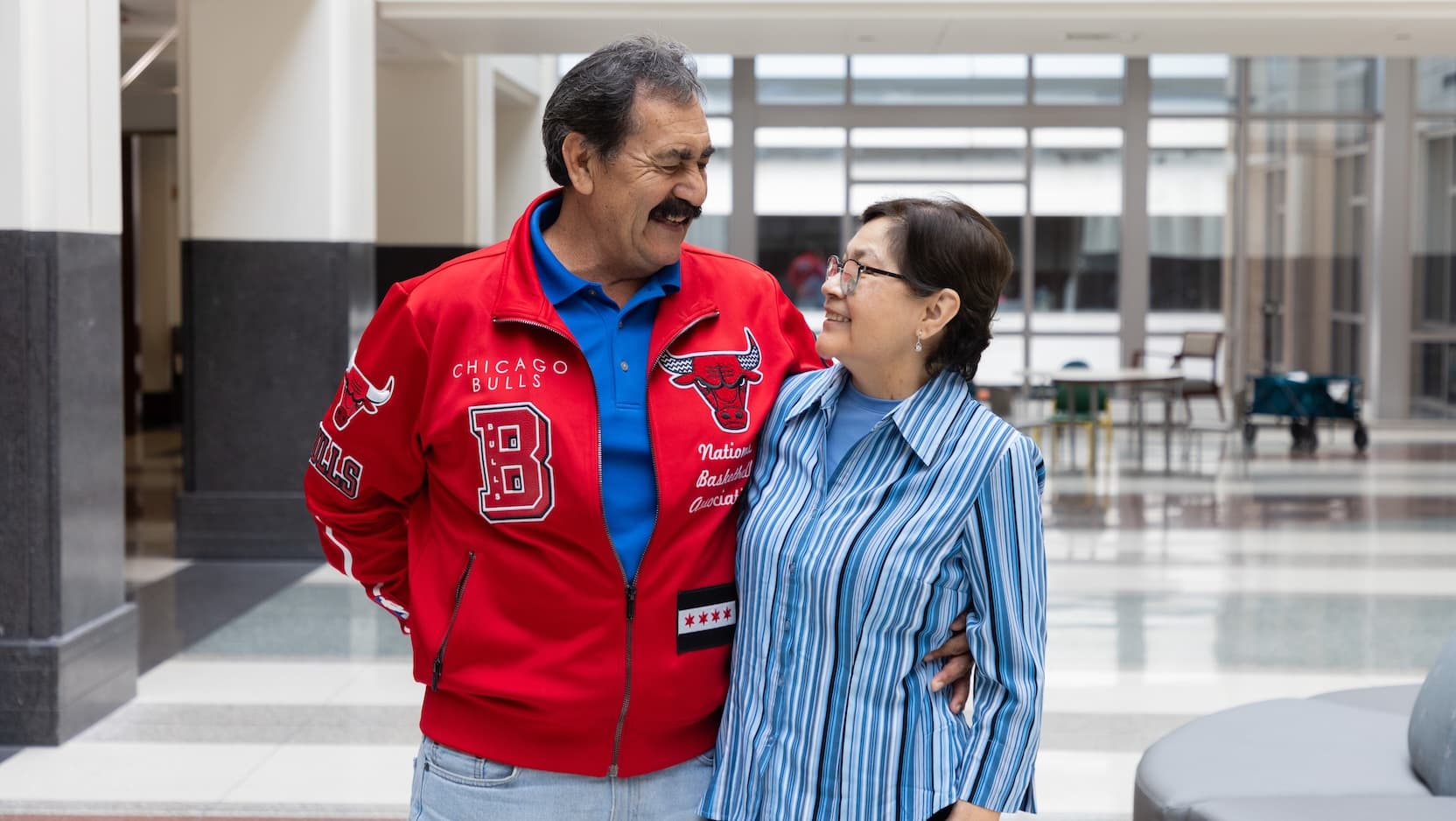Bloodless double-lung transplant, one of Illinois’ first, helps grandmother honor her faith

Teresa Victoria almost didn't make it to the medical appointment that would save her life.
Suffering from end-stage pulmonary fibrosis, Victoria was on a flight to Chicago last December when the battery in her portable oxygen concentrator died. While flight attendants provided an emergency oxygen canister, her need was so great that it ran out after 15 minutes.
"That's when I felt I was going to die," said Victoria, 68, a resident of Lakeland, Florida. "I couldn't breathe."
But Victoria made it to a consultation with Pablo Sanchez, MD, surgical director of the University of Chicago Medicine's Lung Transplant Program. She hoped for the seemingly impossible: a double-lung transplant using no transfused blood to align with her religious beliefs.
"I think that she never expected for us to say, ‘Let's see what we can do,’” Sanchez said.
A devastating discovery
Forty years earlier, Victoria was hospitalized with pneumonia. She later experienced periods of phlegm build-up and coughing. Her doctors in Florida routinely prescribed medications, including an albuterol inhaler, to help.
But it wasn't until 2023 that a doctor in Mexico diagnosed her with stage 2 idiopathic pulmonary fibrosis — a condition characterized by scarring of the lung tissue. The scarring damages the lung tissue, including the air sacs and small blood vessels that help bring oxygen into the body.
"Your lungs are not as flexible and elastic," Sanchez said. "Oxygen doesn't transfer well because the lungs start getting harder and harder."
The irreversible scarring of both of Victoria's lungs led her to be hospitalized for breathing issues every few months and to use a portable oxygen concentrator constantly. Most of her days were spent sitting or lying down.
"It was bad," said her husband, Patalla, shaking his head. "Really bad."
With her condition worsening, Victoria was given roughly a year to live. She was approved for a double-lung transplant in 2024.
Nevertheless, several surgeons in Florida would not operate because of her age, frailty or decision not to receive blood. Victoria is deeply committed to her faith as a Jehovah's Witness, which doesn’t support the use of blood transfusions.
"I was more afraid of blood than the transplant because I didn't want blood," she said.
Minimizing blood loss for better outcomes
Sanchez was confident he and his team could help Victoria become one of the first bloodless double-lung transplant recipients in Illinois.
"Everybody else said ‘no’ to Teresa, but we didn't say ‘yes’ because we were crazy," said Sanchez, who approaches every transplant surgery with the goal to lose as little blood as possible — because the less blood lost, the better the outcome.
"We said ‘yes’ because we knew we could help her through all of this."
Bloodless transplant surgeries were developed to treat patients with certain religious beliefs, and UChicago Medicine’s transplant team has adapted these techniques for lung transplants. Rade Tomic, MD, medical director of UChicago Medicine's Lung Transplant Program, said the method produces better outcomes and has a lower risk of graft dysfunction, arrhythmias and stroke.
Nevertheless, few medical centers are able to undertake the procedure when both lungs are being transplanted.
"Nobody in our region is doing it because without the ability to transfuse the patient, it's a technically challenging procedure," Tomic said.
Successful bloodless lung transplant surgery and recovery
Shortly after her arrival, Victoria was admitted to stabilize her health, build up her iron and hemoglobin levels and gain weight before the operation.
On February 19 — after weeks of nervous anticipation and musings from Patalla that one of the medical helicopters they could see landing from his wife's hospital room might be carrying her donor's gift — Sanchez began the operation to replace Victoria's diseased lungs.
He began by opening Victoria's chest and connecting her heart to an extracorporeal membrane oxygenation (ECMO) system to temporarily replace the work being done by her lungs. He first removed the left lung and ensured there was minimal blood loss.
"We paid a lot of attention because we did not want this patient to bleed in the ICU later," Sanchez said.
After carefully connecting the new lung's pulmonary arteries and veins to Victoria's existing blood vessels, Sanchez allowed blood to flow into the lung and made sure it would ventilate before repeating the same procedures with the right lung.
After 10 hours of work, the transplant was complete. Sanchez asked Victoria to open her eyes.
"I opened my eyes and smiled," Victoria said. "I was so happy."
Breathing easier after double-lung transplant
With her breathing improving by the day, Victoria no longer needs a portable oxygen concentrator.
She still has frequent check-ups in order for doctors to fine-tune her medications and monitor her health, but the couple is renting an apartment in Chicago for one year so that she can easily attend her rehabilitation appointments.
Other than being readmitted once to the hospital due to being weak after a planned scope of her lungs, Victoria continues to make progress.
Patalla keeps a pill organizer the size of an iPad to store the dozens of pills his wife takes every day. Victoria is looking forward to those pills being reduced over time — and she's excited about an upcoming visit from her son and grandchildren.
"Before the transplant I couldn't do anything anymore, and now I can do life's daily activities," she said. "It was worth it."
Lung Transplantation at UChicago Medicine
Whether you have a straightforward condition or a very complex case, our lung transplant specialists have the expertise to help you. We treat a variety of lung conditions, including cystic fibrosis, pulmonary hypertension, Alpha-1 antitrypsin deficiency and pulmonary fibrosis.
Read more about our lung transplant program